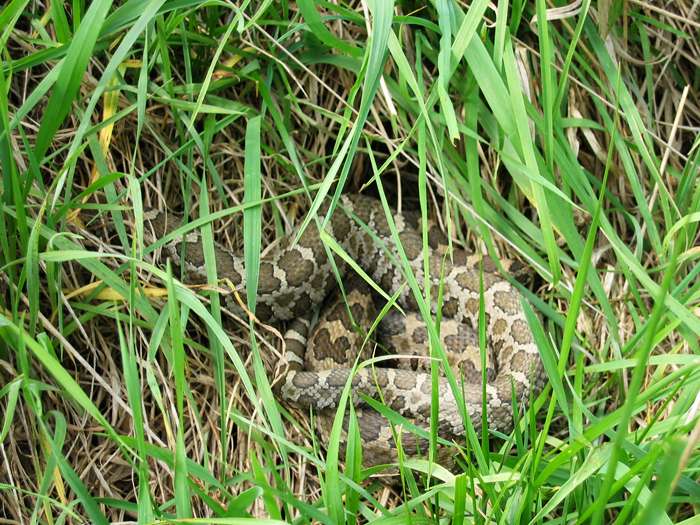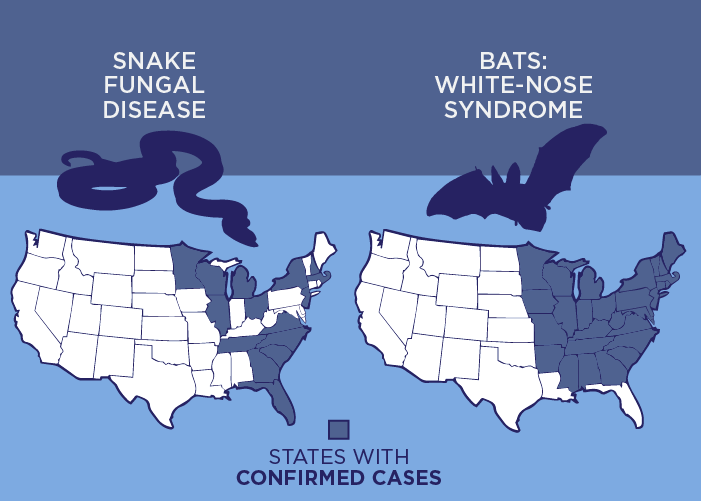Snake fungal disease parallels white-nose syndrome in bats

A deadly fungal infection afflicting snakes is eerily similar to the fungus that causes white-nose syndrome in bats, researchers report.
Although Ophidiomyces ophiodiicola (the snake fungus) and Pseudogymnoascus destructans (the bat fungus) inhabit different ecological niches and thrive at different temperature and humidity ranges, the fungi share basic traits that allow them to persist across a range of habitats and infect multiple species, the researchers report in the journal Fungal Ecology.
"The fungus killing these snakes is remarkably similar in its basic biology to the fungus that has killed millions of bats," said Illinois Natural History Survey mycologist Andrew Miller, an author on the study. "It occurs in the soil, seems to grow on a wide variety of substances, and it possesses many of the same enzymes that make the bat fungus so persistent." INHS is a division of the Prairie Research Institute at the University of Illinois.
The snake and bat pathogens both emerged in North America in the mid-2000s, and each is sweeping across the United States and into parts of Canada. Researchers and wildlife officials have struggled to keep up with the wave of infections and find ways to protect the animals.
White-nose syndrome afflicts bats that are hibernating in cool caves, depleting their energy stores and killing more than 90 percent of those infected. Snake fungal disease is active at higher temperatures.
O. ophiodiicola consumes keratin, a key ingredient in snake scales. It can cause scabs, nodules, abnormal molting, ulcers and other disfiguring changes to snake skin and other tissues. Mortality in infected snakes appears to be 100 percent.

Both the bat and snake fungi can survive on most carbon and nitrogen sources found in soils, said Illinois doctoral student Daniel Raudabaugh, who analyzed both in Miller's lab. "Like the bat fungus, the snake fungus is tolerant of elevated sulfur compounds," Raudabaugh said. "It grows on dead fish. It grows on dead mushrooms - most complex carbon sources. It can utilize nitrate, but its growth is not nearly as robust (as the bat fungus) on nitrate."
"The snake fungus has the ability, just like the bat fungus, to live as a saprobe, consuming dead organic matter," Miller said. "It doesn't need the animal to live, but it's out there attacking the animal now. Why is it doing it? I don't know."
It may be that the snakes are newly susceptible to a pathogen that has always been there, said Illinois comparative biosciences professor and study co-author Matthew Allender, who was the first to report snake fungal disease in a free-ranging population of rattlesnakes in Illinois.
"We know that the fungus is out there, we know that it's killing snakes, but is it killing healthy snakes or is it killing snakes that are already weakened from some other cause?" Allender said. Habitat degradation, pollution, stress from human encroachment and severe weather all may worsen snake health, potentially making snakes more susceptible to disease, he said.
"Ophidiomyces ophiodiicola is an emerging infectious disease," said Frank Gleason, an honorary research fellow at the University of Sydney and a co-author on the study. "Because it can grow within such a wide range of environmental conditions and is highly virulent, it could be spread to new habitats by the release of infested pet snakes and by the international animal trade, infecting many more species of snakes worldwide."

Both the bat and snake fungi infect a variety of species. Seven species of North American bats have been diagnosed with white-nose syndrome. Other species have tested positive for the fungus, but have not been confirmed to have WNS. Snakes affected by snake fungal disease include northern water snakes, eastern racers, rat snakes, timber rattlesnakes, Eastern massasaugas, pygmy rattlesnakes and garter snakes.
"While attention to white-nose syndrome is gaining steam in scientific circles, researchers have been slower to recognize similar emerging diseases in reptiles and amphibians,"Allender said.
To address this and other gaps, the Partners for Amphibian and Reptile Conservation this year formed a national disease reptile and amphibian task team, which Allender co-chairs.
"This is a collaborative effort among biologists, veterinarians and habitat managers to actually assess the risks and minimize the effects of disease," Allender said. "It started in large part because of efforts, like ours, to understand these emerging diseases. Because as you go out and you gather more and more information, you realize you're just scraping the surface."
Provided by University of Illinois at Urbana-Champaign
















